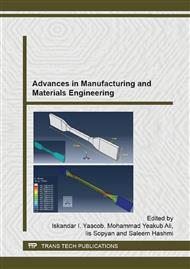p.321
p.325
p.331
p.337
p.341
p.345
p.349
p.353
p.357
Sol-Gel Derived Zinc Doped Calcium Phosphate Bioceramics Prepared via Different Sintering Strategies
Abstract:
Sinterability of zinc doped calcium phosphate (CaP) sintered via conventional pressureless and two step sintering methods was investigated. The starting powders have been synthesized through sol-gel method with zinc concentration varied in the range of 0, 1, 4, and 10mol%. After uniaxial pressing, the compacts were sintered via conventional pressureless sintering. The dense samples were studied in terms of the phase stability, relative density, Vickers hardness, and fracture toughness. The phase of samples was hydroxyapatite and β-tricalcium phosphate. The presence of Zn caused a change in the sintering behaviour of dense calcium phosphate. Zn doping has improved relative density of 4mol% Zn-doped by 8.1% compared to undoped fired at 1300°C. The maximum fracture toughness of 1.43 MPa.m1/2 and Vickers hardness of 3.44 GPa were achieved at 1200°C by 4 mol% Zn-doped. The low Vickers hardness and fracture toughness obtained for dense samples sintered of two step sintering compared to conventional pressureless sintering is due to the low measured bulk density. This study showed that conventional pressureless sintering was beneficial in producing high toughness of Zn doped CaP.
Info:
Periodical:
Pages:
341-344
Citation:
Online since:
July 2015
Authors:
Keywords:
Price:
Сopyright:
© 2015 Trans Tech Publications Ltd. All Rights Reserved
Share:
Citation:


